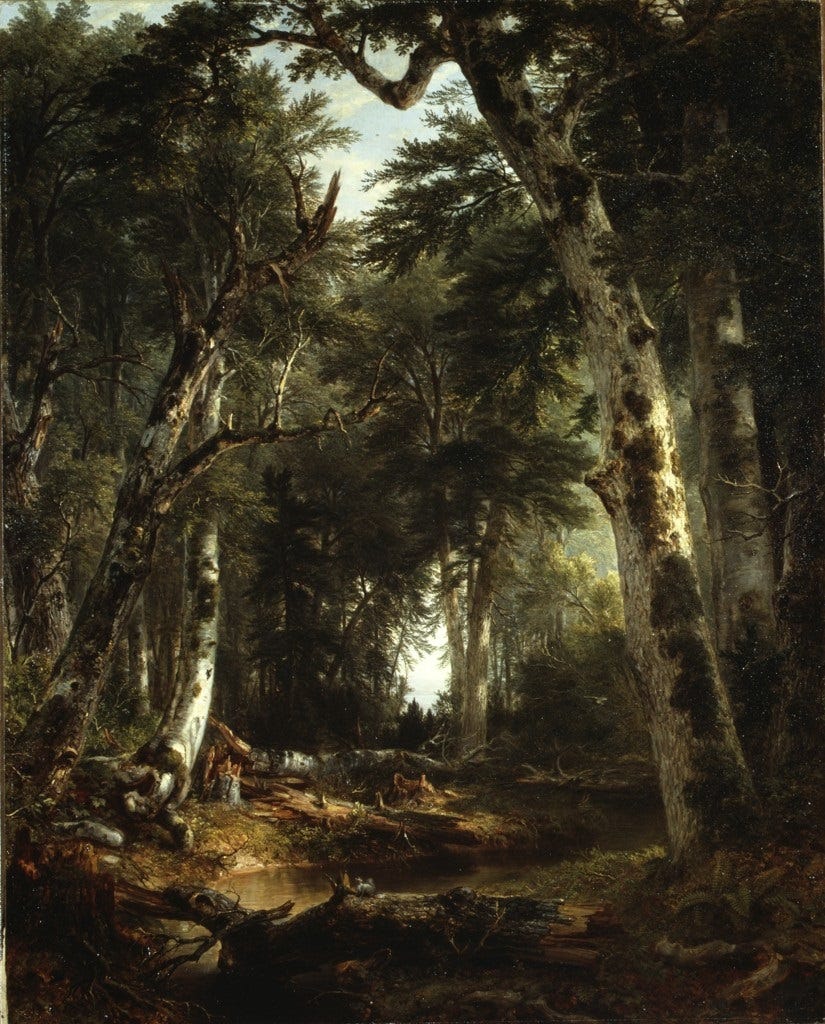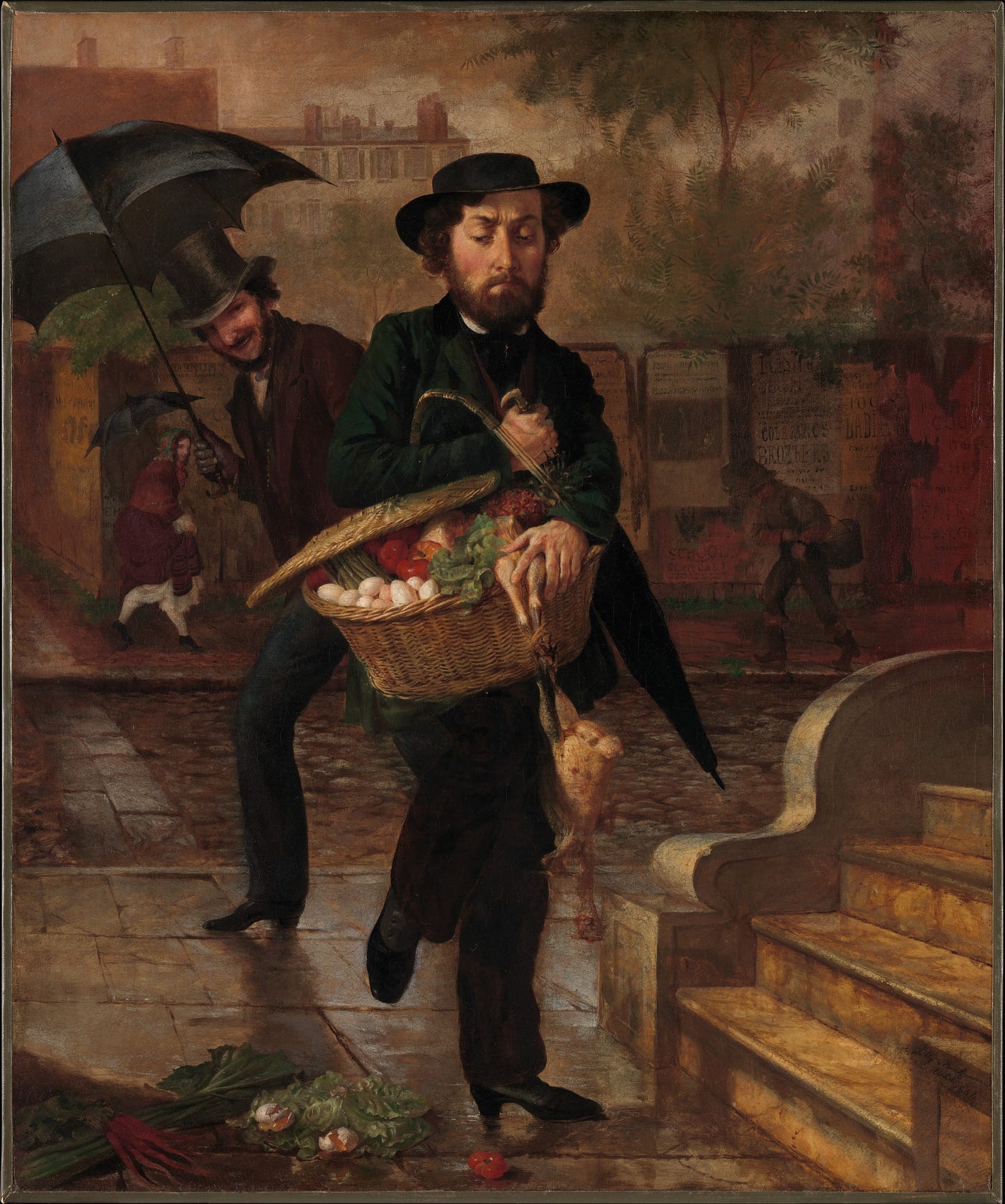[Editor’s Note: Over the course of 2022 and 2023, New American History Executive Director Ed Ayers is visiting places where significant history happened, and exploring what has happened to that history since. He is focusing on the decades between 1800 and 1860, filing dispatches about the stories being told at sites both famous and forgotten. This is the 17th installment in the series.]
New York City emerged early in the life of the new nation as the most important American city. It boasted 500,000 inhabitants by 1850 and, thanks in part to massive immigration from Ireland in the wake of the potato famine, 800,000 in 1860. Brooklyn, a separate city, grew to 200,000 inhabitants by 1860, bypassing Baltimore, Boston, and New Orleans.
New York’s economic dominance grew with the completion of the Erie Canal, a growing railroad network reaching far into the hinterland, and the emergence of an immense transatlantic cotton trade brokered by the city’s finance and insurance elites. Its Native and Dutch origins had faded into distant memories evoked mainly by place names, and the spirit of commerce helped establish an unapologetic tone of life. The nation’s leading newspapers, magazines, and books emanated from New York, and so did its art, theater, and music. In 1855, one book in particular evoked the sweep and surge of life in the swelling metropolis: Walt Whitman’s Leaves of Grass.
A veteran journalist, carpenter and printer, and a frequent visitor to New York’s operas, bars, and docks, Whitman had many opportunities to take in the astonishing breadth of the city. He invented new poetic forms to convey and celebrate what he saw. Neglected and despised at first for his audacity, Whitman lived long enough to see growing numbers of admirers embrace him and his work long after he had written his first astonishing poems.
Finding pieces of the New York that inspired Whitman’s 1850s work proved difficult when we debarked from Bertha, our RV. The wooden and brick buildings of Whitman’s raw and rambunctious metropolis had long given way to imposing towers of steel and glass. The city had absorbed into its grid the poor and remote neighborhoods where he had lived and loafed. What had endured from Whitman’s era were the narrow streets of Greenwich Village and the shaping presence of the Hudson River.
We began at the East River, where we sought scenes from Whitman’s powerful meditation on “Crossing Brooklyn Ferry”:
I am with you, you men and women of a generation, or ever so many generations hence,
Just as you feel when you look on the river and sky, so I felt,
Just as any of you is one of a living crowd, I was one of a crowd,
Just as you are refresh’d by the gladness of the river and the bright flow, I was refresh’d,
Just as you stand and lean on the rail, yet hurry with the swift current, I stood yet was hurried,
Just as you look on the numberless masts of ships and the thick-stemmed pipes of steamboats, I looked.
I longed to feel as Whitman did, but the living crowd was not at the river, nor on the ferry.
In Whitman’s day, the ferry across the East River to Brooklyn was bustling, diverse, and leisurely, but today’s crossing takes all of eight minutes. Sleek, enclosed vessels scoot from modernistic terminals across the water, beneath mammoth bridges and over submerged subways, each shore shining on the water. The river did indeed refresh in its bright flow, but the scene did little to evoke the feeling of the 1850s. We decided to take a most un-Whitmanesque Uber to the other side of the river.
In downtown Brooklyn, where the poet lived with his mother and brother, we found Walt Whitman Park. The small site sits near the now-demolished place where Whitman had helped set the type for the first printing of Leaves of Grass at a publisher of phrenological treatises and guides. A quotation from “Crossing Brooklyn Ferry” was one of several Whitman passages carved into a granite slab, onto which water usually spurted from jets for the entertainment of children and pets. The day we visited, though it was hot enough, the water did not flow, and no one cavorted among Whitman’s words. The words chosen from “Crossing Brooklyn Ferry” were devoted to seagulls, with their “motionless wings, oscillating their bodies” in “slow-wheeling circles.” A beautiful image, but without human faces.
We found the Whitman of democracy and diversity, surprisingly, in the World Financial Center Plaza in Battery Park City, built in 1989 and now called Brookfield Place. There, overlooking the Hudson, Whitman’s words from an 1865 poem, “City of Ships,” span a fence railing overlooking a harbor and river.
The words, golden metal on a black iron fence, surprisingly generous in number and length, captured the enduring spirit of New York:
City of the world! (for all races are here;
All the lands of the earth make contributions here;)
City of the sea! city of hurried and glittering tides!
City whose gleeful tides continually rush or recede, whirling in and out, with eddies and foam!
City of wharves and stores! city of tall façades of marble and iron!
Proud and passionate city! mettlesome, mad, extravagant city!
The words had been selected by an alliance of an architect, artists, and designers. The architect came from Iran, where poetry is often included in buildings, and the team agreed to celebrate the words of Whitman and Frank O’Hara, a 20th century New York poet influenced by Whitman.
Whitman knew he was writing for an audience that did not yet exist, for men and women of “ever so many generations hence.” His faith in the future, and in the power of poetry, were especially touching at this site. Whitman’s words framed the ever-changing and ever-enduring river as a radiant silver structure commonly called the Freedom Tower stood at our backs. Whitman’s words, and belief in the democratic promise of America, had withstood the assault of 9/11 and the passage of many generations hence.
Our other destination in Manhattan — the Metropolitan Museum of Art — embodied a stability Whitman had never known. The monumental building, dozens of blocks away on the edge of the Central Park, opened in 1872. Its American Wing, boasting vaulted ceilings, stained glass, and marble statues, displayed paintings from the 1830s, 1840s, and 1850s in calm and order. The setting camouflaged their tumultuous origins in a different kind of New York, when the city supplied the key patrons, academies, and markets for an American art just coming into being.
The most influential American painting of the era stood at center stage in the gallery: Thomas Cole’s 1836 painting known as The Oxbow. Cole, who had established himself as the leading American painter and father of the Hudson River School, intended the view from Mount Holyoke in Massachusetts to be “a union of the picturesque, the sublime, and the magnificent.” Each of those words described a distinct purpose. The “picturesque” meant that the image bore the proportions and perspectives of tranquility many viewers admired. The “sublime” evoked a thrilling and somewhat frightening confrontation with nature’s power and unpredictability, embodied in shattered tree trunks and stormy clouds. The “magnificent” meant that the painting embraced a broad and significant scene, in this case a panorama that told the unfinished story of settlement and deforestation.
Cole’s work combined and juxtaposed these attributes in a way that generations of painters would emulate, but the painting left its message — and the American future — open to interpretation. The river presented a question mark while inscrutable letters, faintly Hebraic, were carved into the forests of the distant hillside.
Adjacent to Cole’s painting stands a strikingly different view of nature by Asher Durand, a friend and student of Cole. Durand, like his teacher, advocated painting in nature rather than in the studio. As head of the New York-based National Academy of Design, Durand held great influence in his example and in his writings. In the 1850s, following Cole’s early and unexpected death, Durand turned to a more intimate view of nature than his master had painted, one that featured no human presence at all. His 1855 work, In the Woods, evoked nature’s indifference to the needs or desires of people. The path forward is blocked by fallen trees and a muddy creek. Durand’s large painting devoted itself to details of bark, stone, moss, and leaf. No picturesque vista beckons, no sublime clouds hover. Instead, Durand’s painting announces nature’s self-sufficiency, its cycles of growth and decay longer than any human life.

Across the gallery from the imposing paintings of Cole and Durand hang a pair of smaller paintings that put people rather than nature on center stage. These works are by the most famous female painter in the United States in the 1850s: Lilly Martin Spencer, who moved to New York from Cincinnati to build her career.
While Walt Whitman was the poet of the vast, living crowds of the streets and docks of New York, Lilly Spencer painted intimate domestic scenes. She created pictures of everyday life, often transformed into prints to adorn parlors and bedrooms. Despite her popularity, Spencer, her husband, and their 13 children moved to rural New Jersey because they could not afford to live in Manhattan. Fame, she confided to her mother, did not pay the bills. She hand-colored prints of her own paintings to help raise money for the family.
Many of Spencer’s paintings and lithographs would now be considered cloying portrayals of small children and their parents, but she chose other subjects as well: humorous pictures of men and women in unflattering moments. Spencer made gentle fun of gender roles — including that of her own husband, who cared for the children while she painted. Spencer’s 1854 work, Young Husband: First Marketing, portrayed a solemn young man trying to maintain his dignity while a plucked chicken, eggs, and tomatoes tumble from his basket to a damp and gritty New York street. A man smirks over his shoulder at the young husband’s incompetence at what would have been considered woman’s work.

But in another painting, the young husband’s counterpart is having no better luck in her woman’s work, making her first stew from the ingredients her husband managed to get home. Onions cause her eyes to burn; she looks disgusted with the work and with herself. A young female servant looks on, apparently no more competent than her mistress.

Spencer’s paintings, like Whitman’s poetry, puncture the stereotypes of this era, stereotypes perpetuated by stiff illustrations in ladies’ magazines and advice manuals. Spencer made fun of images of women as pristine, saintlike, and humorless. Her paintings are accomplished and expert; the meat and vegetables before the young wife reveals Spencer’s skill at representing still life, the clothing of the two women demonstrate her skill at depicting fabrics. But the tone is informal, jocular, and democratic. Lilly Martin Spencer, like Walt Whitman, shows us a New York, and an America, that was more vital, colorful, and restless than many tend to imagine it being.
But our visit to the Bronx home of Edgar Allan Poe would show us yet another surprising side of New York.
